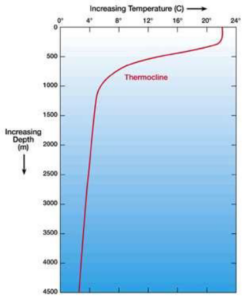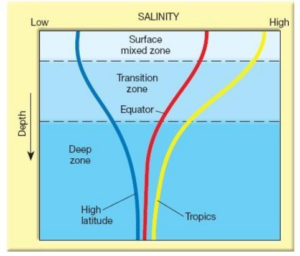31 Jan 2024 : Daily Answer Writing
Q1) Account for the differences in ocean water density across the globe and its diverse implications. (150 words/10 m)
ANSWER
The ocean water across the globe differs in density due to the difference in the parameters of salinity and temperature. The variation can be accounted as:
Temperature:
Figure: thermocline
- The temperature of ocean water varies by location both in terms of latitude and depth, due to variations in solar radiation and the physical properties of water.
- Due to high temperature in the equatorial region the water density decreases because of greater expansion of water molecules.
- Density of sea water becomes comparatively greater in the polar areas, due to decrease in temperature.
- Further, temperature decreases with depth. Hence, for all the oceans, the surface water is at a higher temperature compared to the deep waters (hence, deep water is denser). The boundary region, from where there is a rapid decrease of temperature, is called the thermocline.
Salinity:
Figure: variation of salinity
a) Vertical distribution: salinity, and resultantly density, increases with depth. There is a distinct zone called halocline, where the salinity increases sharply.
b) Evaporation rate: High evaporation rate causes high salinity, and consequently higher density in oceans.
E.g., Arabian Sea has more salinity than equatorial and temperate water.
c) Mixing of ocean currents also impacts the salinity and hence density of the ocean waters.
E.g., North Sea despite its location in the higher latitudes, recodes higher salinity due to saline water brought by the North Atlantic Drift.
d) Amount of Fresh water added in ocean:
- Equator witness heavy rainfall and high humidity so equatorial water bodies have lower salinity than average 35 ppt.
- Oceans fed by large rivers like Amazon, Congo, Ganges, Mekong etc have lower salinity due to heavy influx of fresh water.
E.g., Bay of Bengal; Baltic Sea etc.
III. Polar and subpolar water of Arctic Ocean, and Antarctic region have low salinity (less than 32 ppt) due to fresh water from melting of glaciers.
- Closed or marginal bodies like Red sea, Mediterranean sea etc. have higher salinity due to lack of free mixing of fresh water (often over 37 ppt), thereby increasing the density.
Implications of differences in ocean water densities can be seen as:
- Increasing salinity of seawater causes its density to increase. High salinity seawater, generally, sinks below the lower salinity water. This leads to stratification by salinity.
- Density (salinity) has a major role to play in the formation and circulation of oceanic currents via the thermohaline process. Thermohaline circulations also have a part in the working of global ocean conveyor belt.
E.g., cold water at the poles sinks and slowly moves towards the equator and warm water moves from equator to poles to replace the sinking cold water.
- Since Earth’s temperature and rainfall is affected by currents, the level of salinity has indirect role in impacting the overall climate and the heat budget of the planet.
- 4. Density has a direct impact upon the distribution of marine life.
E.g., majority of the marine life live in the less dense photic zone; higher density due to salinity makes seawater easy to float in for large marine organisms.
- Due to its much lower freezing temperature, saline water makes movements of cargo ships and fishing possible during winters.
- The differences in the temperature between surface waters and deep ocean waters is used for harnessing energy through the process of Ocean Thermal Energy Conversion (OTEC).
Salinity in tandem with the temperature primarily dictate the density of the ocean waters which in turn has the range of economic, ecological, and climatic consequences
Upload Answer here


